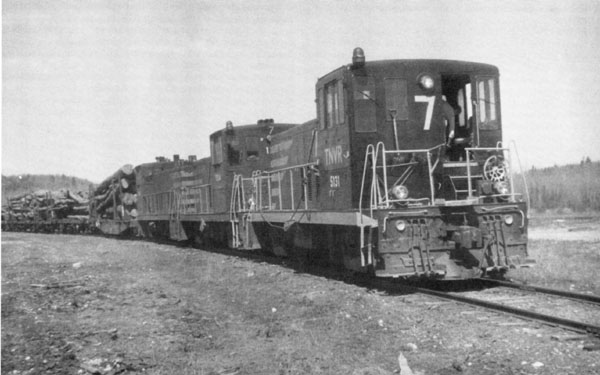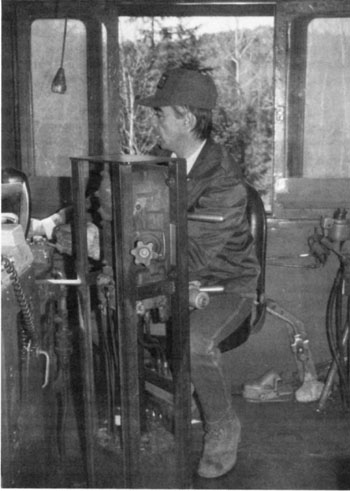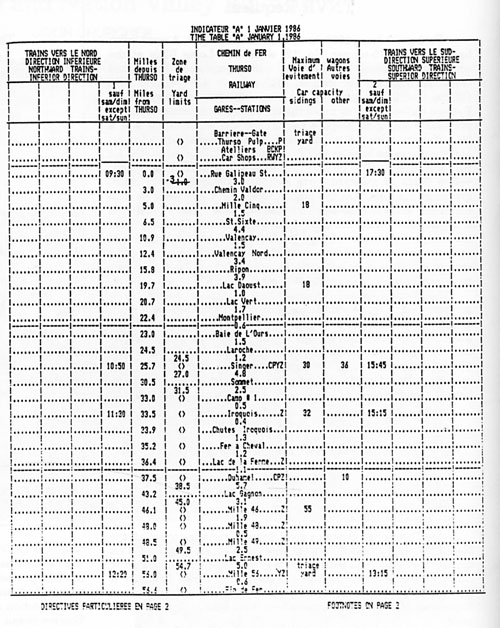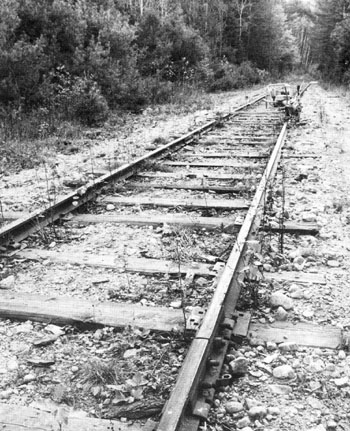|
The Thurso and Nation Valley Railway
- A Requiem

Ready to roll: GE 70-tonner No. 7 (bought new in 1949) with mu-ed sisters 11 (ex-CN 29 [1529 and 7803]) and 12 (ex-CN 36 [1536 and 7810]) are all set up to depart mileage 56 during the late spring of 1986. Note the AAR box car hand brake, the ditch lights and the flashing amber beacon mounted to the cab roof. If nothing else, TNVR locomotives were visible from a great distance. (Photo by Philip Jago) The Thurso and Nation Valley Railway (TNVR) died
five years ago this month. The piece which follows forms one of the chapters
of a history of the line which I have written with fellow BRS member Larry
Hird. We are currently looking for a publisher.
The TNVR was a 56-mile line that brought logs from the Quebec bush to the mill at Thurso which is located along the Ottawa River, some 30 miles east of Ottawa. It was built in the 1920s to provide birch for Singer sewing machine cabinets. It started life with an 0-6-2 tank, a 2-6-2 tender locomotive, and a three-truck Heisler geared locomotive. The steam locomotives were replaced in the mid-1940s by diesels, mainly GE products, 70-ton models with some smaller centre cab 44-ton models. Ancient log cars with truss rods and K triple brake equipment were used extensively until the end. The Bytown Railway Society Inc. now owns Car 27, a small 1907 CPR wooden business car which the TNVR purchased in 1929. But the TNVR was more than just the machines. The people made everything possible. Their ingenuity and work ethic were typical of a short line living on borrowed time. It took a special breed to battle the economic and climatic odds of railroading logs into the silicon chip world of the 1980s. One cannot mention the TNVR without thinking of Gaetan Lafleur, the Superintendent. Thanks to Gaetan, a small group of enthusiasts were privileged to gain an insight into the last logging railway in eastern Canada. For sixty years, the railway disturbed the tranquillity of the north woods with the sounds of logs moving to the Thurso mill. But now the woods are silent and the rails have been removed. I mourn its passing. 
A study in concentration: TNVR Engineer Yves Blouin concentrates on switching action prior to lifting a loaded log train from the end of track at mileage 56. The next few hours will be a contest pitting his talents at the brake valve with the combined dynamics of 42 loaded and idler log cars and descending grades that would make a roller coaster envious. Note the utilitarian interior of GE 70-tonner No. 7. Of especial interest is the disconnected dead man's pedal! (Photo by Philip Jago) TNVR Requiem
Friday, 20 June, 1986 dawned clear and bright. A work extra hauled by GE 70-tonner No. 12, with Jean-Louis Blais at the controls, left Thurso around 08:30 with a gondola, a flatcar, the crane, six log cars for Singer, BRS caboose 436436, and BRS Official Car 27 bringing up the rear. Eleven members of the Bytown Railway Society made the trip, two having come down the previous evening to prepare Car 27 for the last run. It was a beautiful day with a cloudless sky. The air was clear and clean and there was no haze as the little train made its way into the La Blanche valley. The countryside was at its best. The bright yellow fields of mustard were set off against the vivid, clear, greens of the hills. On the lakes the yellow water lilies were in full bloom and even the shy iris could easily be spotted. It was as if the flowers were putting on a show to salute the passing of an era. Stops were made at Singer and just south of Duhamel to pick up some ties and in Duhamel itself to load some speeders. The crane and flatcar were left in the siding at Duhamel and the short train continued to the end of the line at mile 57. As the time passed the smells from the galley became more and more enticing. Wood smoke mingled with the aroma of fresh coffee and to this was added the scent of potatoes baking in the oven. A stop was made at mile 54 for lunch to be prepared and eaten. Colin Churcher and Duncan du Fresne cooked while Paul Churcher served out to the eleven members together with two special guests, Gaetan Lafleur and Laurent Blais. Although hastily cooked, the meal was carefully thought out and prepared: Avocado with home made chutney
Joe Toscas had chosen a good Spanish red wine to set off the New York strip
steak. The meal was eaten off an original TNVR damask tablecloth and with
the help of the silver Canadian Pacific coffee server set presented to the
society by Omer Lavallee at mileage 46 on the occasion of his 55th birthday
celebration on September 14,1980. There was also a small vase of flowers
on the table.Salad TNVR Bifsteak TNVR a 1'argentine Baked potato Fiddleheads Fruit pie Coffee At Lac Facsinant, they quickly wyed the train and dropped off the gondola that would be used to dismantle the line. Then the last journey commenced. No longer would we be able to enjoy Lac Ernest from a logging railway. But the lakes, the trees, the streams will still be there. Nature is constant. All that really changes is the technology that man uses to turn nature to his advantage. Already there were signs that nature was about to claim its own. The daisy, brown eyed susan and Indian paint brush had already begun to carpet the right of way with bright patches of white, yellow and red. In one place, vines had grown across the rails, adding a bright green to the riot of colour. Nature was, indeed, reclaiming its own. 
The crane and flatcar were picked up at Duhamel where they could be put behind the engine. Gaetan Lafleur had to leave the train at Duhamel. He shook hands with everyone and then stood by the section shed watching his train depart for the last time. There was not a dry eye in the place. As they rounded Lac de la Ferme for the last time, six members of the Thurso Gang, Duncan du Fresne, Joe Toscas, Neil Robertson, George Viens, Paul Churcher and Colin Churcher each sought their own private place from which to pay their last respects. Thurso native and BRS member Larry Hird was thinking about what the TNVR had meant to him in his youth in another age when the railway was king. No words were spoken but the look in their eyes told all. Very few pictures were taken as this was the time for private thought. Jean-Louis Blais took No. 12 up the hill to Iroquois in fine style. The Great Walker, Len Purdy, would have been proud at the way the train climbed the hill he had laid out some 45 years earlier. They saluted the tamarack tree at Iroquois. It had never looked very healthy but it would outlast the railway. The extra met the regular train with No. 7 and No. 11 at Singer and the two trains combined. No. 13 helped with this job but stayed behind for the clear out the following day. As they left Singer, Paul Churcher threw out on to the track the posy of wild flowers that had graced the table of Car 27. With 28 loads and 14 idler flats, Jean-Louis Blais had quite a time keeping the slack action under control and there were one or two vicious jolts. The TNVR was fighting to the end. Passing Ripon, the look on people's eyes said: "Hurry up Jean-Louis, let's get this over." At mile 6, a jerk indicated that we were on the down grade and we could smell the brakes being applied. By the time we had reached mile four, one could not see the head end through the blue brake shoe smoke. Jean-Louis drifted along past mile two and made another brake application at the top of the hill down to Thurso. We were accelerating even though he had made a 15 pound brake reduction. Would the old brake shoes hold the old, tired cars just one more time? Gradually, the shoes won the fight against gravity and the train came to a halt in the yard. No. 10 (GE 44-tonner) picked up Car 27 and the caboose and brought them back to the Car Shop. Ornery to the last, No. 10 had bent a side rod earlier that day and had to complete its work with two side rods. It was as if it knew that this was to be the last day on which it would be needed. The last load was brought down sixty years almost to the day after the first. The TNVR went out the way it had existed for all of its 61 years. It was not run down or gradually emasculated to pass imperceptibly from view. The last train was a heavy one. The railway performed the role for which it had been built right to the end. The last run was carried out just like any other - quietly and effectively. The locomotives were not decked out in bunting, nor was there any indication that this was anything other than a regular run. The railfans on Car 27 had come dressed for the occasion and kept quietly out of the way. There were no motorcaders. Best of all, there were no reporters to sensationalize the news and distort the facts. As we shook hands with Laurent Blais and wished him luck, there was a dull ache in the pits of our stomachs. It was the way one feels when one has lost a good friend who has been sick for some time with no hope of recovery. We had just witnessed an act of euthanasia. 
|
![]()



